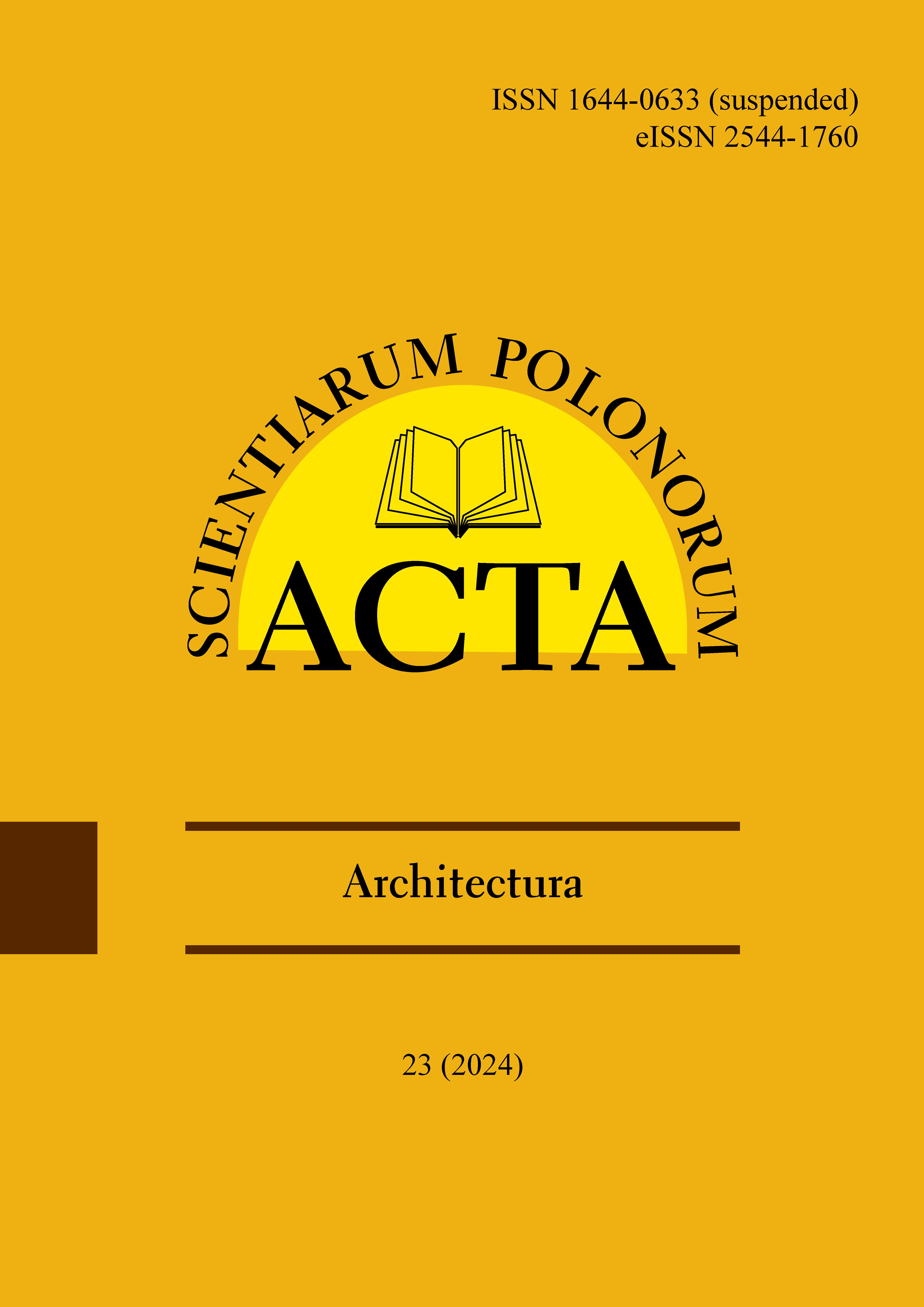Main Article Content
When designing multi-family buildings on plots that have not yet been developed, an important element is their location and its careful preparation. Pre-design analyses allow for the simulation of various solutions in order to select the most advantageous location of individual volumes and accompanying spaces. Appropriate arrangement of architecture and other land development functions helps to meet a number of formal and legal requirements, but also provides an opportunity for effective and comfortable living in a future multi-family development. The aim of the study is to show the possibilities offered by pre-design analyses in terms of sunlight and the organisation of space between buildings. Another goal is to outline the benefits of performing such analyses. Thanks to them, it is possible to use compromise in design solutions when it turns out that individual variants of a building location have better or worse properties, or certain conditions are mutually exclusive. The results were presented in the form of variants, presenting various land development solutions and relating directly to the previously conducted analyses. The analyses presented in the article allow for precise formulation of conclusions, and their selection is justified by the possibility of transparent and graphical interpretation of the algorithms performed during design.
Article Details
Ai, Z. T. & Mak, C. M. (2015). Comparison of Single-Sided Ventilation Characteristics between Single-Storey and Multi-Storey Buildings due to Wind Effect. International Journal of Ventilation, 14 (2), 181–190. https://doi.org/10.1080/14733315.2015.11684079 (Crossref)
Blocken, B. (2015). Computational Fluid Dynamics for urban physics: Importance, scales, possibilities, limitations and ten tips and tricks towards accurate and reliable simulations. Building and Environment, 91, 219–245. https://doi.org/10.1016/j.buildenv.2015.02.015 (Crossref)
Chohan, A. H., Che-Ani, A. I., Shar, B. K., Awad, J., Jawaid, A. & Mohd Tawil, N. (2015). A Model of Housing Quality Determinants (HQD) for Affordable Housing. Journal of Construction in Developing Countries, 20 (1), 117–136.
Davies, M., Steadman, P. & Oreszczyn, T. (2008). Strategies for the modification of the urban climate and the consequent impact on building energy use. Energy Policy, 36 (12), 4548–4551. https://doi.org/10.1016/j.enpol.2008.09.013 (Crossref)
Goodfellow, T. (2020). Political Informality: Deals, Trust Networks, and the Negotiation of Value in the Urban Realm. The Journal of Development Studies, 56 (2), 278–294. https://doi.org/10.1080/00220388.2019.1577385 (Crossref)
Grochulska-Salak, M. (2021). Re-urbanization in a model of sustainable development of an eco-city [Reurbanizacja w modelu zrównoważonego rozwoju eco-city]. Acta Scientiarum Polonorum. Architectura, 20 (1), 3–12. https://doi.org/10.22630/ASPA.2021.20.1.1 (Crossref)
Hong, B. & Lin, B. (2014). Numerical study of the influences of different patterns of the building and green space on micro-scale outdoor thermal comfort and indoor natural ventilation. Building Simulation, 7 (5), 525–536. https://doi.org/10.1007/s12273-014-0167-6 (Crossref)
Hooff, T. van, Blocken, B., Timmermans, H. J. P. & Hensen, J. L. M. (2016). Analysis of the predicted effect of passive climate adaptation measures on energy demand for cooling and heating in a residential building. Energy, 94, 811–820. https://doi.org/10.1016/j.energy.2015.11.036 (Crossref)
Kanda, M. (2007). Progress in Urban Meteorology: A Review. Journal of the Meteorological Society of Japan. Ser. II, 85B, 363–383. https://doi.org/10.2151/jmsj.85B.363 (Crossref)
Kobylarczyk, J. & Marchwiński, J. (2019). Uban sozology assumption in the planning of housing areas. Czasopismo Techniczne, 10, 21–34. https://doi.org/10.4467/2353737XCT.19.105.11029 (Crossref)
Kobylarczyk, J. & Marchwinski, J. (2020). Pluralism of goals of proecological architecture. Budownictwo i Architektura, 19 (1), 005–014. https://doi.org/10.35784/bud-arch.1595 (Crossref)
Marchwiński, J. & Zielonko-Jung, K. (2013). Ochrona przeciwsłoneczna w budynkach wielorodzinnych: Pasywne rozwiązania architektoniczno-materiałowe. Warszawa: Oficyna Wydawnicza Wyższej Szkoły Ekologii i Zarządzania.
Memon, R. A. & Leung, D. Y. C. (2011). On the heating environment in street canyon. Environmental Fluid Mechanics, 11 (5), 465–480. https://doi.org/10.1007/s10652-010-9202-z (Crossref)
Mirzaei, P. A. & Haghighat, F. (2010). Approaches to study Urban Heat Island – Abilities and limitations. Building and Environment, 45 (10), 2192–2201. https://doi.org/10.1016/j.buildenv.2010.04.001 (Crossref)
Moonen, P., Defraeye, T., Dorer, V., Blocken, B. & Carmeliet, J. (2012). Urban Physics: Effect of the micro-climate on comfort, health and energy demand. Frontiers of Architectural Research, 1(3), 197–228. https://doi.org/10.1016/j.foar.2012.05.002 (Crossref)
Obwieszczenie Ministra Rozwoju i Technologii z dnia 15 kwietnia 2022 r. w sprawie ogłoszenia jednolitego tekstu rozporządzenia Ministra Infrastruktury w sprawie warunków technicznych, jakim powinny odpowiadać budynki i ich usytuowanie (Dz.U. 2022 poz. 1225. Retrieved from: https://isap.sejm.gov.pl/isap.nsf/DocDetails.xsp?id=WDU20220001225 [accessed: 28.11.2023].
Obwieszczenie Marszałka Sejmu Rzeczypospolitej Polskiej z dnia 10 marca 2023 r. w sprawie ogłoszenia jednolitego tekstu ustawy – Prawo budowlane (Dz.U. 2023 poz. 682). Retrieved from: https://isap.sejm.gov.pl/isap.nsf/DocDetails.xsp?id=WDU20230000682 [accessed: 28.11.2023].
Okeil, A. (2010). A holistic approach to energy efficient building forms. Energy and Buildings, 42 (9), 1437–1444. https://doi.org/10.1016/j.enbuild.2010.03.013 (Crossref)
Rybak-Niedziółka, K. (2018). Miasto jako krajobraz [City as landscape]. Warszawa: Komitet Przestrzennego Zagospodarowania Kraju PAN.
Starzyk, A., Donderewicz, M., Rybak-Niedziółka, K., Marchwiński, J., Grochulska-Salak, M., Łacek, P., Mazur, Ł., Voronkova, I. & Vietrova, P. (2023). The Evolution of Multi-Family Housing Development Standards in the Climate Crisis: A Comparative Analysis of Selected Issues. Buildings, 13 (8), 1985. https://doi.org/10.3390/buildings13081985 (Crossref)
Tofiluk, A. (2020). New housing development of Warsaw in the context of sustainable design and climate change – city guidelines and recommendations [Nowa warszawska zabudowa mieszkaniowa w kontekście projektowania zrównoważonego i zmian klimatycznych – miejskie wytyczne i rekomendacje]. Acta Scientiarum Polonorum. Architectura, 19 (4), 37–49. https://doi.org/10.22630/ASPA.2020.19.4.36 (Crossref)
Toparlar, Y., Blocken, B., Maiheu, B. & Van Heijst, G. J. F. (2017). A review on the CFD analysis of urban microclimate. Renewable and Sustainable Energy Reviews, 80, 1613–1640. https://doi.org/10.1016/j.rser.2017.05.248 (Crossref)
Turunen, M., Paanala, A., Villman, J., Nevalainen, A. & Haverinen-Shaughnessy, U. (2010). Evaluating housing quality, health and safety using an Internet-based data collection and response system: A cross-sectional study. Environmental Health, 9 (1), 69. https://doi.org/10.1186/1476-069X-9-69 (Crossref)
Downloads
- Michał Golański, Justyna Juchimiuk, Mikołaj Donderewicz, Jacek Kwiatkowski, Przemysław Łacek, Magdalena Pożarowszczyk-Bieniak, Anna Piętocha, The complex remodelling of academic buildings: the case study of the Water Centre at Warsaw University of Life Sciences (SGGW) Campus , Acta Scientiarum Polonorum. Architectura: Vol. 24 (2025)

This work is licensed under a Creative Commons Attribution-NonCommercial 4.0 International License.


 Knowledge base
Knowledge base